
A Guide to Strategic Networking: Maximising Your Professional Connections
Have you ever felt overwhelmed by the prospect of networking? You're not alone. For many professionals, the idea of striking up conversations with strangers or strategically expanding their professional circle can feel daunting, even anxiety-inducing. But what if we told you that networking doesn't have to be a source of stress, but rather an exciting opportunity for growth and connection?
In today's fast-paced professional landscape, strategic networking has become more crucial than ever. It's not just about collecting business cards or adding LinkedIn connections; it's about building meaningful relationships that can propel your career forward.
This comprehensive guide will demystify the art of networking, providing you with practical strategies to expand your professional circle, enhance your visibility, and unlock new opportunities. Whether you're a seasoned professional or just starting your career journey, these insights will help you transform networking from a dreaded task into a powerful tool for success.
What is Networking

At its core, networking is exchanging knowledge, ideas, and resources among individuals with shared professional interests or goals. In the modern, interconnected business landscape, networking has evolved from a mere job-seeking tool to a crucial element of career development and business growth.
Unlike reactive networking, which often occurs in response to immediate needs, proactive networking involves:
Continuous Engagement: Regularly participating in industry events, online forums, and professional associations.
Relationship Building: Fostering connections with colleagues, mentors, and industry peers over time.
Knowledge Sharing: Contributing insights, resources, and expertise to your professional community.
Importance of Networking?
Since nearly 70% of individuals are hired by companies where they have personal or professional connections, networking is a critical aspect of the career exploration process. However, beyond making personal connections with others in careers of interest to you, networking allows you to gain insight into many aspects of work, including

Three Principles of Good Networking:
Successful networking hinges on three fundamental principles: intention, diversity, and consistency. Integrating these elements into your networking strategy can cultivate a robust and enduring professional ecosystem.

Intention:
Networking should be a mutually beneficial endeavour. Focus on creating value for your connections, not just seeking personal gain. By focusing on developing such reciprocal relationships, you’ll learn how critical balanced exchanges are for long-term success.
Strategies for Intentional Networking:
Actively listen during conversations to identify potential synergies
Facilitate introductions between contacts who could benefit from knowing each other
When connecting with others, provide concise context to highlight potential common ground
Be open to reciprocal introductions from your network
Diversity:
A well-rounded network resembles a web rather than a linear structure. It should encompass various professional and personal connections across multiple experience levels and industries.
Sources for Diverse Networking:
Current and former colleagues
Academic connections (classmates, professors)
Industry association members
Peers from digital professional networks like LinkedIn
Personal interest groups (sports teams, community organisations)
Industry leaders
Executive members of a company you aspire to work at
Specialised recruiters in your field
Remember to engage with individuals at all career stages, from emerging talents to seasoned mentors and industry leaders.
Consistency:
Transform networking into a habitual practice by establishing a routine incorporating regular engagement with your professional community.
Habits for Consistent Networking:
Schedule regular check-ins with former colleagues
Engage consistently on professional social media platforms
Attend industry events regularly
Allocate time for follow-ups and nurturing connections
Share relevant content (articles, podcasts) with your network when it reminds you of them
Seize opportunities to make introductions within your network
By embracing these three pillars, you can develop a networking approach that expands your professional circle and creates lasting, meaningful connections that contribute to your long-term career success.
Setting Clear Networking Goals
Like everything, your direction is more critical than your travel speed. Networking is no different. Many focus on connecting with as many people as possible without having a goal to strive towards.
Before developing your networking strategies, it is essential to understand the motivations and objectives behind your activities.
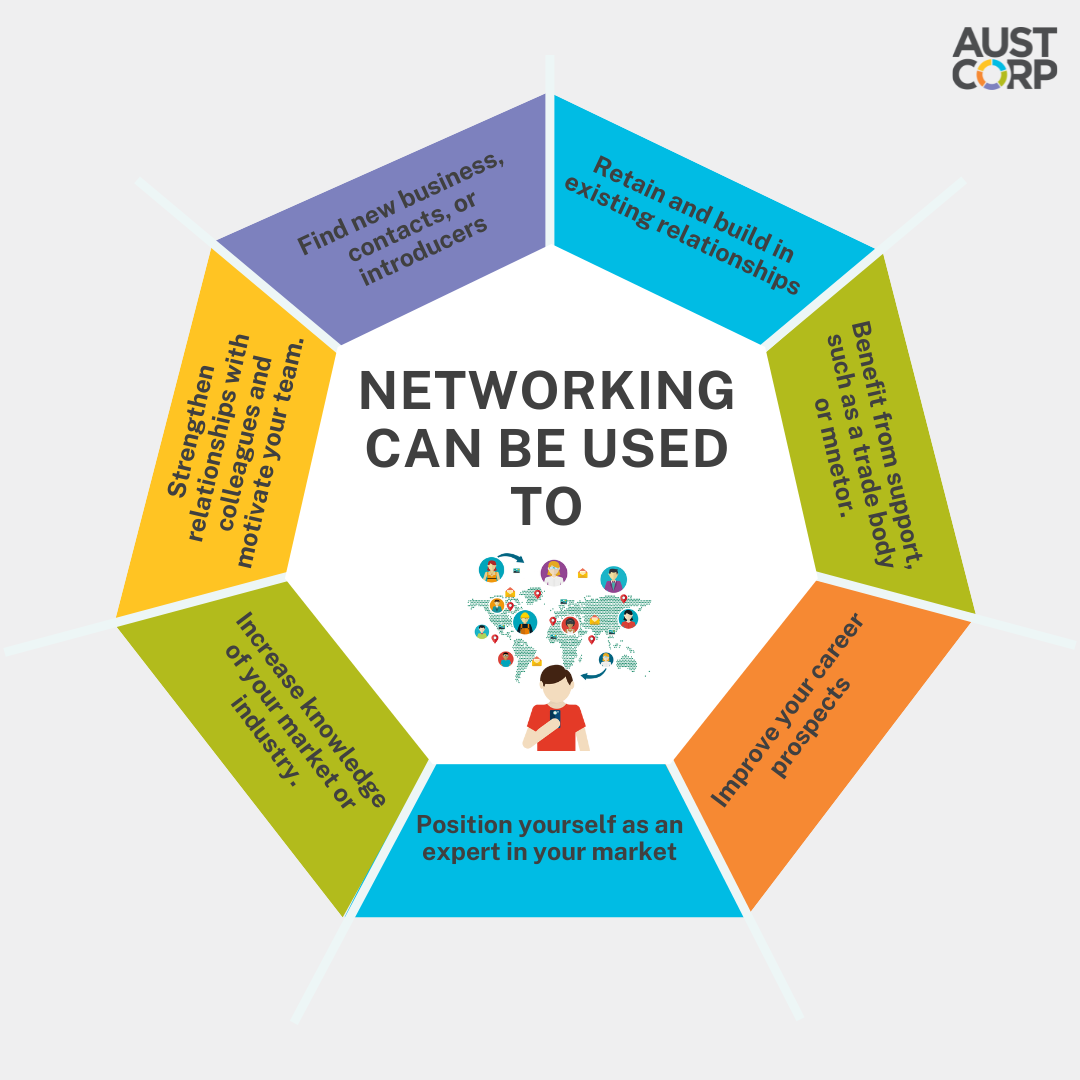
Your networking goals should help you achieve your career goals. Think about where you want to be in your career in the next 1-5 years:
What job do you want? What skills or successes do you hope to have?
What kind of work interests you?
What projects could help you grow?
Are there any leadership roles or special skills you are aiming for?
Once you have a good idea of your career goals, identify 1-2 objectives behind your networking activities. By answering these questions and identifying your primary motivations, you will gain clarity on your networking objectives and be better equipped to set meaningful goals.
Work out how many contacts you need.
Before reaching out to potential contacts, you need a clear idea of who you want to connect with and why. Your ideal network should consist of people with skills, knowledge, experience, influence, or resources you need or want to access. You should also consider how you can add value to them and what relationship you want to establish.
STEP ONE: Start by identifying the groups of people you need to connect with to achieve your objectives. For example:
Reason to network | Contacts/activities - numbers |
Job Opportunities | Recruitors, Hiring Managers, Executive Leaders (Working at target companies) and past Co-workers with influence in hiring. |
Mentorship and Guidance | Experience Mentors, Industry Leaders, Career Coaches |
Industry Insights and Trends | Thought leaders, Influencers in your field, Executive Leaders in your field, Analysts |
Skill Development | Trainers, Workshop Leaders, Peers with Complementary Skills |
Personal Branding | Marketing Professionals, Social Media Experts, Content Creators and influencers in your field |
Networking for Business Growth | Entrepreneurs, Investors, Business Development Specialists, ect. |
STEP TWO: Once you have identified your groups, you need to consider the current contacts in your network. This might be past co-workers, university alums, social media connections, people you have met at past events, ect— group each of these connections into the appropriate group you have previously established.
STEP THREE: Analyse and refine these connections. Going through each group and connection consider,
How can this person help me achieve my networking objectives?
What value can I bring to this person and their goals?
How established is the current relationship? If I reach out to them now with a request, can they deliver it?
You should only include contacts who are genuinely valuable to your goals and to whom you can provide value. Remove them from your list if they are not valuable to your current goals.
STEP FOUR: Using this current list, identify what type of contacts/relationships you are missing and how many are missing for each group.
These gaps will help you identify your SMART goals down the line. However, right now, quantify your networking goals. For example, you may have one current senior leader in your network, so you might aim to connect with three industry leaders and nurture your current contact into a more established relationship. For example:
Reason to network | Current Connections | New Connections Needed |
Job Opportunities | 2 Recruitors, 1 Hiring Manager | 3 Recruitors, 3 Hiring Managers (Working at Target Company) |
Mentorship and Guidance | 1 Senior Professional | 3-5 Potential Mentors |
Industry Insights and Trends | 3 Industry Peers | 5-7 Thought Leaders |
Skill Development | 1 Workshop Leader | 5 Trainers or Skilled Peers |
Personal Branding | 1 Marketing Professional | 2 Branding Experts, 2 Influencers |
Networking for Business Growth | 1 Entrepreneur | 3 Investors, 6 Business Development Experts |
Selecting Effective Networking Channels
With the groundwork carefully prepared, it's time to build your professional network by considering one, more, or all of the following strategies. When selecting your networking methods, think about your target audience—where they are most likely to be active—and the norms of your industry.
Different fields have varying networking cultures; for instance, tech professionals may prefer online platforms, while legal professionals might favour traditional face-to-face interactions. Additionally, consider your personal strengths: if you excel at writing, contributing to industry publications could be a great fit, whereas if you thrive in social settings, attending events may be more effective.
Be realistic about the time and resources you can dedicate to networking and tailor your approach according to your career stage—whether you’re a recent graduate, mid-career professional, or senior executive.
Maximising Coworker Interactions
Engaging with current and past colleagues can be a valuable networking strategy. This can be a great way to start, as you have already established trust and camaraderie with these individuals. To make the most of these interactions, consider using open-ended questions that encourage meaningful dialogue:
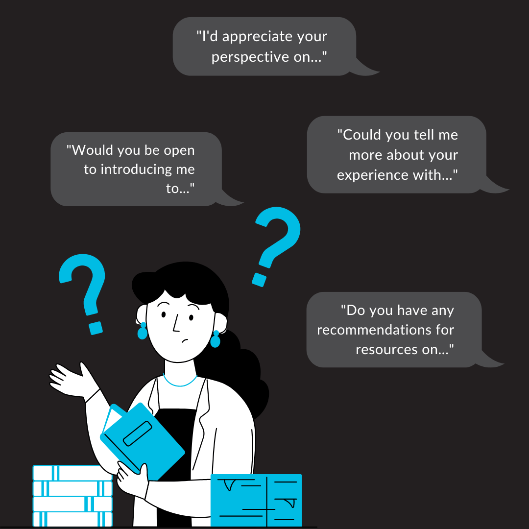
These prompts help steer conversations towards mutually beneficial information exchanges and potential opportunities.
Joining Professional Associations
Professional organisation such as Engineers Australia & Nursing and Midwifery Board of Australia (NMBA) are groups that represent the interests of a certain industry. As umbrella organisations, they assist individuals and organisational members through learning, networking, and research.
Industry organisations often host seminars, conferences, and workshops exclusively for members. These events are a great way to meet other members within your industry, learn new things, keep up with trends, and explore different perspectives.
Setting Up Informational Interviews
Informational interviews are a valuable networking tool that can provide insights into specific careers, organisations, and potential job opportunities. These meetings, typically informal and brief, allow you to gather information from professionals working at an organisation you might want to work for or an individual in a field you'd like to learn about or transition into.
Informational Interviews allow you to
Gain Industry Insights: By speaking with professionals in your target field, you can obtain valuable "insider" information about the industry, company culture, and job roles. This firsthand knowledge can help determine if a particular career path aligns with your goals and personality.
Expand Your Network: These casual in-person or virtual meetings can lead to unexpected opportunities and connections. You may be remembered for future job openings or referrals by making a positive impression.
Improve Interview Skills: Informational interviews provide a low-pressure environment to practice your communication and self-presentation skills, which can boost your confidence for formal job interviews.
Whether you are starting your career or seeking a transition, informational interviews can be helpful at any point.
How to ask for an informational interview
When reaching out for an informational interview, being respectful, concise, and clear about your intentions is essential. Here's a sample template:
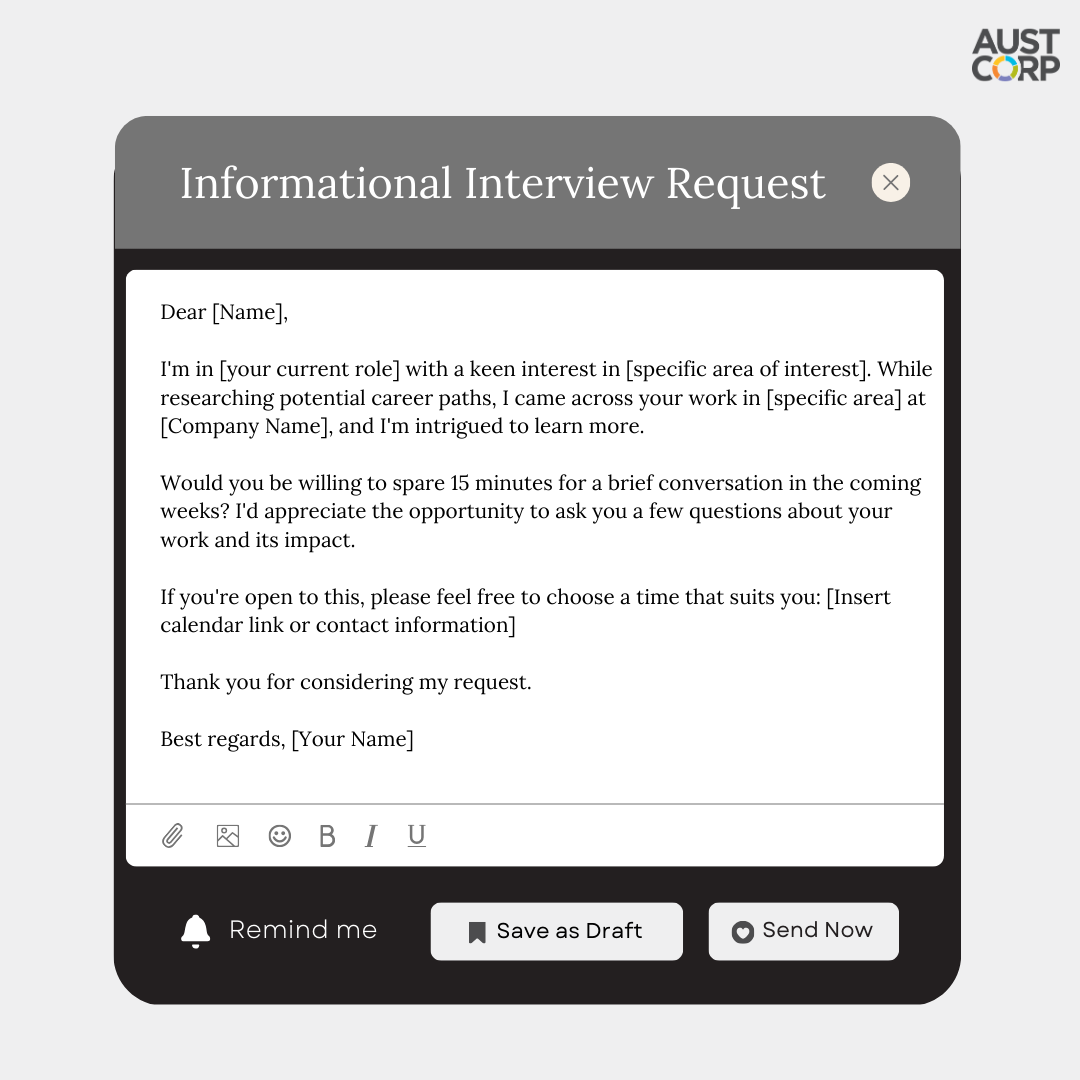
How to Make the Most of an Informational Interview
There's no "single best way" to conduct an informational interview, but you should remember that you are the interviewer, not the interviewee. Show up prepared and make the most of your time.
Some good questions to ask:
What excited you the most when you joined this company?
What excited you now? Anything you're less excited about?
What is the work atmosphere like on your team?
How would you rate the work/life balance?
What people excel on this team (or at this company)?
What skills does the company (or team) look for when hiring people?
Are there other people you might recommend I speak with to learn more?
May I stay in touch as I continue exploring possibilities?
After the interview is over, be sure to send an immediate thank you note and, if appropriate, extend an invitation to connect on LinkedIn.
Also, if you follow any advice the interviewee suggests (and have positive results), continuously loop back around and let them know what happened. Most people love knowing they've provided cheerful counsel, which gives you another opportunity to build rapport.
Leveraging Social Media
In today's dynamic professional landscape, the essence of networking, particularly leveraging LinkedIn for professional networking, cannot be overstated. Networking, the art of cultivating meaningful connections, plays a pivotal role in career development. As we navigate the maze of opportunities and challenges, one platform stands out as a beacon for professionals seeking to expand their horizons—LinkedIn.
As a powerhouse in professional networking, the platform transcends traditional boundaries, connecting professionals across industries and countries. LinkedIn serves as a digital CV, offering a space to showcase skills, experience, and accomplishments. With millions of users, indivdiuals can forge valuable relationships that foster collaboration, knowledge sharing, and mutual support by connecting with colleagues, industry peers, and thought leaders. These connections often lead to new opportunities like job offers, partnerships, and mentorship.
By actively participating in industry discussions, sharing valuable insights, and publishing relevant content, professionals can establish themselves as thought leaders in their respective fields while forging authentic and valuable connections.
Your LinkedIn Profile:
In today's interconnected world, potential employees, recruitors, clients and almost everyone in your network will likely look you up online. Having a LinkedIn profile allows you to create a strong first impression by showcasing your skills, experience, and accomplishments in a polished and professional manner.
Headline
Your profile headline is your own personal ad. That’s why you should treat it like your mission statement – encapsulating who you are and why people should connect with you.
Here is a basic formula you can follow to help you create an effective LinkedIn headline.
(Current Role/Profession) | (Primary Skills/Area of expertise) | (Unique Value) | (Notable Achievement) | (Personal Passion or Career Goal)
Examples:
Project Manager | Expert in Agile & Scrum Methodologies | Delivering High-Quality Projects On Time
Software Engineer | Full-Stack Developer | Specialized in React & Node.js | Passionate About Building Scalable Solutions
Project Manager | Agile & Scrum Specialist | Leading High-Impact Teams
Graphic Designer | Adobe Creative Suite & UX Design | Creating Engaging Visuals
Financial Analyst | Data Analysis & Forecasting | Enhancing Business Decisions
Project Manager | Agile & Scrum Specialist | Leading High-Impact Teams
Graphic Designer | Adobe Creative Suite & UX Design | Creating Engaging Visuals
Financial Analyst | Data Analysis & Forecasting | Enhancing Business Decisions
Professional Profile Picture
Your profile picture is your calling card on LinkedIn—it's how people are introduced to you and governs their impressions from the start. Ensure the picture you choose is recent and looks like you, with at least 60% of your face in the photo wearing what you would wear to work and smiling with your eyes.
A LinkedIn Summary
Crafting a LinkedIn summary might seem unnecessary, especially if you're not actively job hunting or frequently using the platform. However, a well-written LinkedIn summary is essential for advancing your career. For sales professionals, it serves as a valuable tool for social selling, while for others, it can open doors to new career opportunities.
Although LinkedIn provides up to 2,000 characters for your summary, it's important to avoid lengthy, unfocused paragraphs that lack structure. Following a clear format can help you convey your message effectively and succinctly.
Hook: Start with a compelling sentence that captures attention and encourages the reader to continue. Remember, only the first three lines are visible when someone visits your profile, so make sure your hook entices them to click "see more."
Mission: Explain your motivation and what drives you in your professional life.
Expertise and Skills: Highlight your key strengths and areas of expertise.
Accomplishments: Provide examples of how your skills have led to successful outcomes in the past.
Call to Action: Clearly state what you want the reader to do after reading your summary.
See below for three examples of outstanding LinkedIn summaries from which you can draw inspiration:

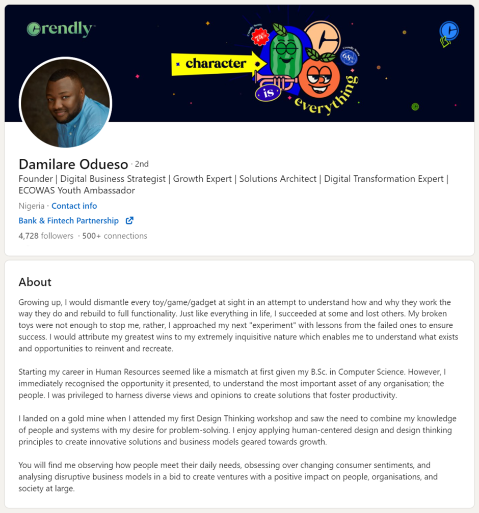

Detailed Work Experience
LinkedIn's "Experience" section is your opportunity to showcase your past and present roles, responsibilities, and work history to your professional network. LinkedIn allows for more detailed descriptions than a resume, which typically offers a brief overview.
Here are a few things to remember when crafting your profile experience section:
Use First-Person Narrative: Write in the first person with a conversational tone. Use the present tense for your current role and the past tense for previous positions.
Conciseness is Key: Each sentence should be impactful and worth the reader's time. Avoid unnecessary details to keep your descriptions brief.
To maintain consistency, use a structured format and follow the same layout for each role description.
Use a structured format for each role. Subheadings like "Responsibilities," "Achievements," and "Software Used" can help organise information and make it easier to read.
Use bullet points instead of lengthy paragraphs to enhance readability.
Avoid complex vocabulary. Clear and simple language ensures broader understanding.
Action Verbs: Start descriptions with strong action verbs such as implemented, managed, directed, organized, reduced, or enhanced.
Describe your Responsibilities: Clearly outline your responsibilities with 3-4 bullet points, mentioning the product or service you worked on. For example:
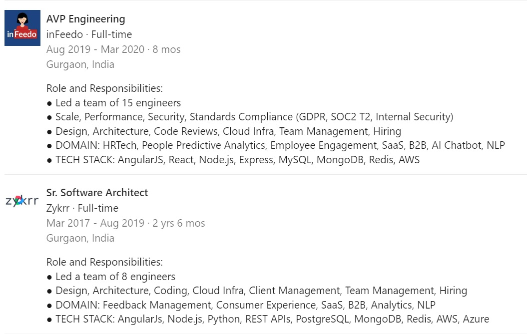
Highlight Accomplishments: Emphasize significant achievements by quantifying them with numbers and percentages. This approach effectively markets your skills to potential employers by showcasing tangible results.
For example:
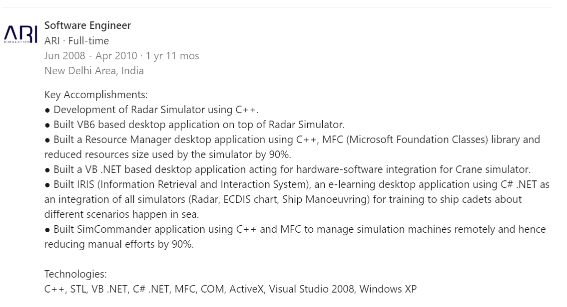

Attach Relevant Media to your Experiences
LinkedIn offers the ability to enhance your profile by adding media such as images, documents, websites, and presentations to each experience entry. This feature allows you to provide social proof, thereby increasing the credibility of your profile. If you have content like articles, white papers, case studies, or designs, showcasing them can give your audience a clearer understanding of your work. Here’s how to add media to your LinkedIn profile:
Navigate to your profile and enter edit mode.
Scroll down to the "Experience" section and click the pencil icon to edit a specific experience.
In the "Media" section, click "Add media."
You can then choose to add a link. For example, if you have a SlideShare presentation, copy and paste the link here.
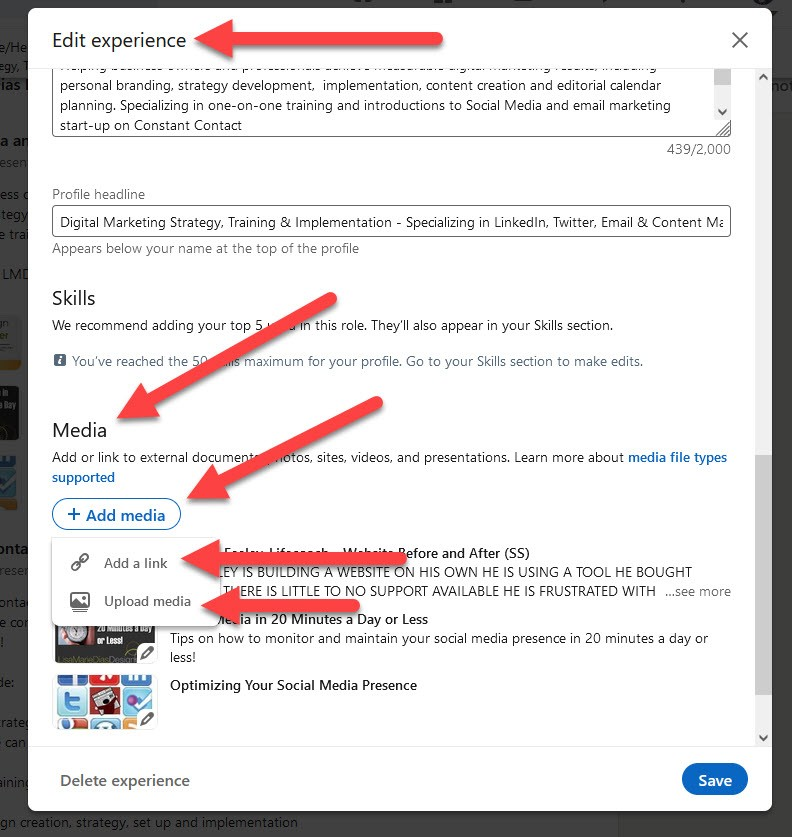
Highlight your Skills
Skills are one of the quickest wins on LinkedIn. Scroll through the list of skills and identify those that are relevant to you. Doing so helps to substantiate the description in your headline and summary and provides a platform for others to endorse you.
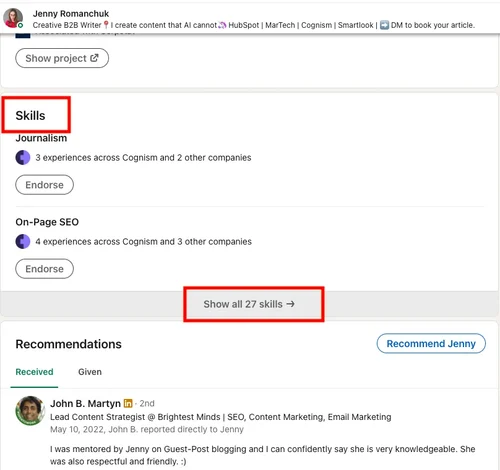
Endorsements highlight a person's strengths and expertise. For example, if you worked with me on a content marketing campaign and were impressed with my content creation and on-page SEO skills, you can choose to endorse me for content writing. This would allow my profile visitors to gain insights into my top skills.
It serves as a more compelling validation of my abilities than merely listing them on my resume or self-reporting, as these endorsements come directly from people who have had first-hand experience with your work.
Important: Make sure your "Endorsements settings" are "On". Here's how:
Go to the "Skills Section"
Click on the three dots and select "Endorsement Settings."

Toggle the settings to "Yes" and click "Save."
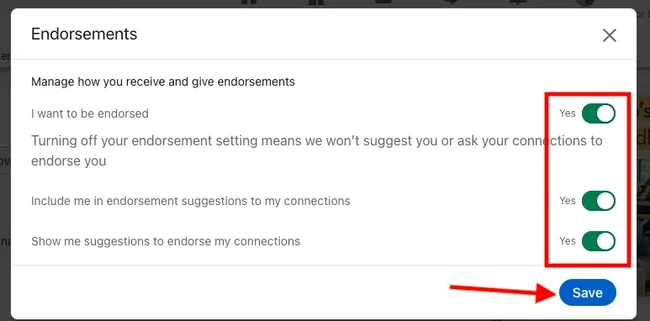
But how do you get endorsed on LinkedIn? For starters, go through your network and identify connections with whom you feel genuinely deserve an endorsement from you – that is often the trigger for people to return the favour.
Don't be afraid to reach out with a polite request asking for endorsement for a few skills. Customise your request by referencing the project you collaborated on with them and gently job their memory regarding your contributions. Show that you value their opinion and clearly mention the skill or skills you'd like them to endorse. Be specific and concise in your request. Say something like:
"Hi (Name),
It's been some time since we chatted. I enjoyed our collaboration and work together. I'd like to request your endorsement for my "Specific skill" on LinkedIn. Your support would help stregthen my professional profile.
If there's anything you'd like me to do in return, please let me know. I'm more than happy to reciprocate.
Thank you in advance for your support.
Best regards,
(Your Name)"
Testimonials
Although skill endorsements highlight your expertise, recommendations are at the next level. Serving as testimonials, recommendations detail your collaboration, projects completed, or skills developed. Consider contacting close contacts for recommendations that apply to your current role – or next career goal. You can contact past colleagues, managers, customers or even former classmates.
Connecting with New People:
Expanding your professional network on LinkedIn is highly beneficial as it opens up opportunities for collaboration, career advancement, and access to industry insights. By connecting with individuals in your field who could become future collaborators or valuable contacts, you enhance your visibility and credibility within your industry. It's important to target connections that align with the ideal personas you identified when setting your networking goals. This strategic approach ensures that your network is composed of individuals who can support your professional growth and align with your objectives.
Here are some strategies for finding potential networking contacts:
Sync Your Email Address Book: By syncing your email with LinkedIn, the platform can suggest people you might want to connect with.
Follow Up on Meetings: After meetings or conversations, send LinkedIn connection requests to maintain the relationship.
Reach Out to Existing Contacts: Connect with people you already know, such as colleagues, former employees, clients, and university peers.
Utilise "People You May Know": LinkedIn suggests potential connections under the “My Network” tab whenever you connect with someone new.
Use the Search Box: Filter your searches by location, company, connection level, and more to find specific contacts.
Engage in LinkedIn Groups: Join groups that match your interests and actively participate to connect with relevant members.
When sending a connection request, always include a personalised note. Avoid using generic invitations; instead, briefly introduce yourself, explain your role, and state why you want to connect. This personal touch increases the likelihood of a positive response.
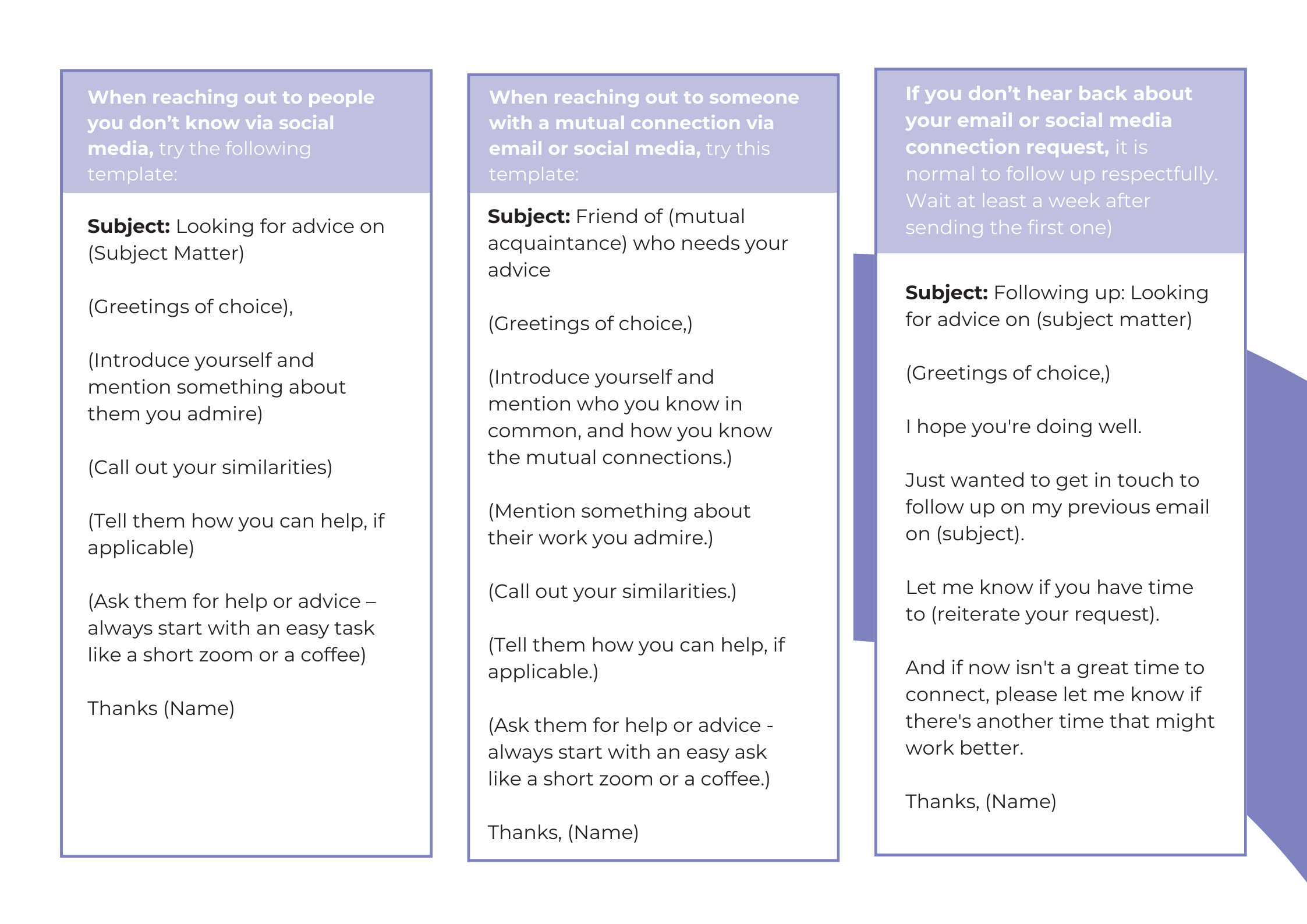
Engaging with your Connections:
Building a network isn't just about acquiring followers; it's about engaging with them regularly. Set aside 20-30 minutes daily to liking, commenting and sharing relevant posts from your network. Respond to comments on your posts, answer messages promptly, and show genuine interest in your follower's work or opinions. Daily engagement will keep you visible in your network's feed whilst nurturing those contacts.
PRO TIP: Use ContactOut's AI Commenter via Chrome Extension. This app allows you to use AI to comment on posts, giving you the option to
Add Value
Questions
Compliments
Say Thank You
Remember to personalise and revise the generated content to suit your tone of voice and personality, adding any additional insights or comments. You can also use this extension to write your personalised messages for connection requestions:
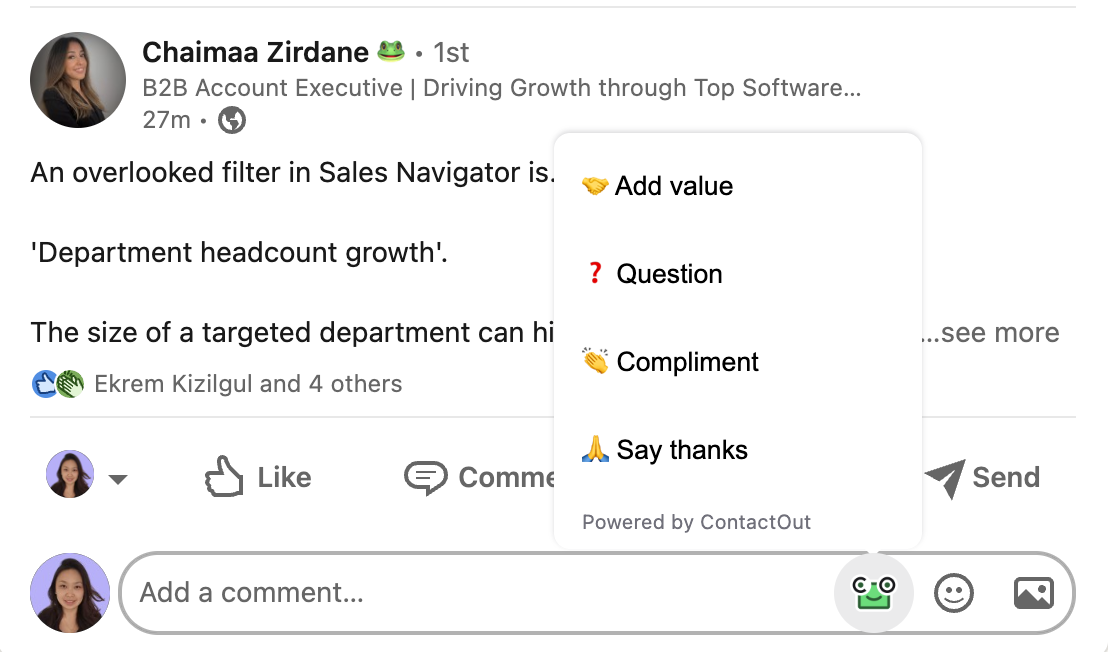
Posting Content:
While the most successful networking entails you interacting with others, you'll also want to provide that opportunity to others by posting content. This not only allows your network to interact with you, it also allows you to share your expertise - stregthening your LinkedIn brand and positioning you as a thought leader.
Plus, it can help you broaden your reach. Your posts have the potential to go beyond your immediate network through LinkedIn's algorithm and content discovery features. This means that your valuable insights can resonate with a wider audience, attracting new connections.
If you are struggling with what and how to post on LinkedIn, the following articles have some great advice and ideas:
Attend virtual events:
LinkedIn offers various virtual events, such as webinars, workshops, and conferences. Take advantage of these opportunities to learn, network, and connect with professionals in your industry. Engage actively by asking questions, participating in discussions, and connecting with speakers and attendees.
Joining LinkedIn Groups:
LinkedIn groups are excellent for networking, allowing you to market yourself or your business while expanding your professional connections. By joining groups related to your industry, expertise, or interests, you can share insights, ask questions, and participate in discussions. This engagement enhances your visibility and helps grow your network by demonstrating your expertise and authenticity. However, it's important to be selective when choosing groups. Opt for those that are relevant to your profession and goals, ensuring they are active with substantial membership and discussions that align with your interests.To maximize the benefits of LinkedIn groups:
Start Meaningful Discussions: Initiate conversations by posting thought-provoking questions, sharing interesting articles or resources, and seeking advice from group members.
Share Insights and Expertise: Contribute valuable insights, offer advice, and provide solutions to common challenges in your field.
Scout for Potential Connections: Engage with individuals who share similar interests, connect with them, and interact with their content and posts.
Attending Industry Events
Conventions and conferences often occur throughout the year, and provide an opportunity for professionals within the same industry to attend talks, make connections and participate in activities.
These gatherings provide an excellent opportunity to meet like-minded professionals and engage in conversations that can lead to mutually beneficial relationships.
Before the Event:
Identify your goals for attending:
What is your goal, and who do you want to meet and connect with? Just because an event takes place doesn’t mean you must be there. Ask yourself if it makes sense to be present. Once you have confirmed it is relevant for you to attend, it is an excellent idea to set specific objectives so you can focus on meaningful interactions rather than aimlessly navigating the event. Be specific with your goals; for example, you might identify three professionals you would like to meet and introduce yourself to, or there might be particular workshops you would like to attend.
Research about the event:
Conferences are generally packed with presentations, panels, and even some hands-on skill-building sessions. Take the time to read all the pre-event materials sent your way and plan your agenda. Which sessions are you most excited about? Do any of them have conflicting times? Make a schedule of time to attend panels and presentations, look at booths, and connect your current connections.
Identify any current network contacts that may be going and reach out:
If the event is significant and many people from your industry will be attending, you may want to reach out to some of your connections beforehand to find out who is attending. An excellent way to do this is to make a simple post on LinkedIn advertising that you will be going to and ask anyone else who is going. You can then arrange times to catch up for coffee or coordinate events where you can attend together.
During the event
Striking a balance between expanding your network and consolidating it:
The people you meet at a networking event will fall into two categories: those you have met before and those you are meeting for the first time. Ideally, you should strike a balance between the two, using the event to reconnect with familiar faces (especially if there are people you recognise but haven’t yet gotten to know well) while also seeking brand-new connections.
Your emphasis should be on reconnecting briefly and, if appropriate (or desirable), sharing details that will allow you to catch up in the future.
Introducing yourself with confidence:
Time constraints often come into play during event networking scenarios. So always be ready to share who you are, what you do, and what you want in 30 seconds or less. Distil it down into a snappy overview. You should rehearse this quick pitch beforehand until it flows smoothly and confidently. This ensures you make a memorable first impression.
Once you have introduced who you are and what you do, you should focus on shared experience. What is the most apparent thing you and the other person have in common? To begin with, you are both at the same networking event, so some possible follow-ups may include
What did you think of the presentation earlier?
How did you find out about this networking event?
I wonder if these events are usually so crowded.
Build rapport by discussing the topic of interest: Let's say the person you are talking with is an accountant. What do they most like about it? Have they learned anything interesting lately? The trick here is to get people talking about something they are passionate about. Alternatively, you could lead the way by sharing an interesting anecdote about your experiences. Remember, the best conversations don't involve only an exchange of facts but also an exchange of excitement and enthusiasm.
You don't need to sell yourself: Networking events aren't competitions where you have to impress everyone you meet. The erroneous belief that doing so is necessary will only result in undue pressure and, often, a wooden performance when making introductions. A more sensible goal is to focus on learning more about the other person to see if you have common interests and goals and whether or not there might be ways you can help each other.
Relax: Meeting new people can be challenging. You deserve credit for being bold enough to converse with somebody you haven't met before. Once you've done so, it is easier to go with the flow, and by being at ease with yourself, you will also help the other person relax.
Ending the conversation politely: To do so, reverse your introduction. Wait for an appropriate null in the conversation, then issue a polite exit line such as "It has been great meeting you, but I want to ask the speaker/colleague some questions before they leave OR Well, I want to make sure to say hello to at least three people tonight, OR anyways I don't want to take up all of your time". You can then thank the person in a specific way: "Thanks for sharing your experiences as …. You have helped me answer some important questions OR I appreciate you telling me more about life within COMPANY". Then shake hands and, with conviction, depart to do what you said you would do.
After the event:
Follow-Up:
It is essential to follow up promptly with everyone you meet after an event. You should send them personalised emails or LinkedIn messages thanking them for meeting and expressing interest in future collaboration. Quick follow-ups show professionalism and keep the momentum alive.
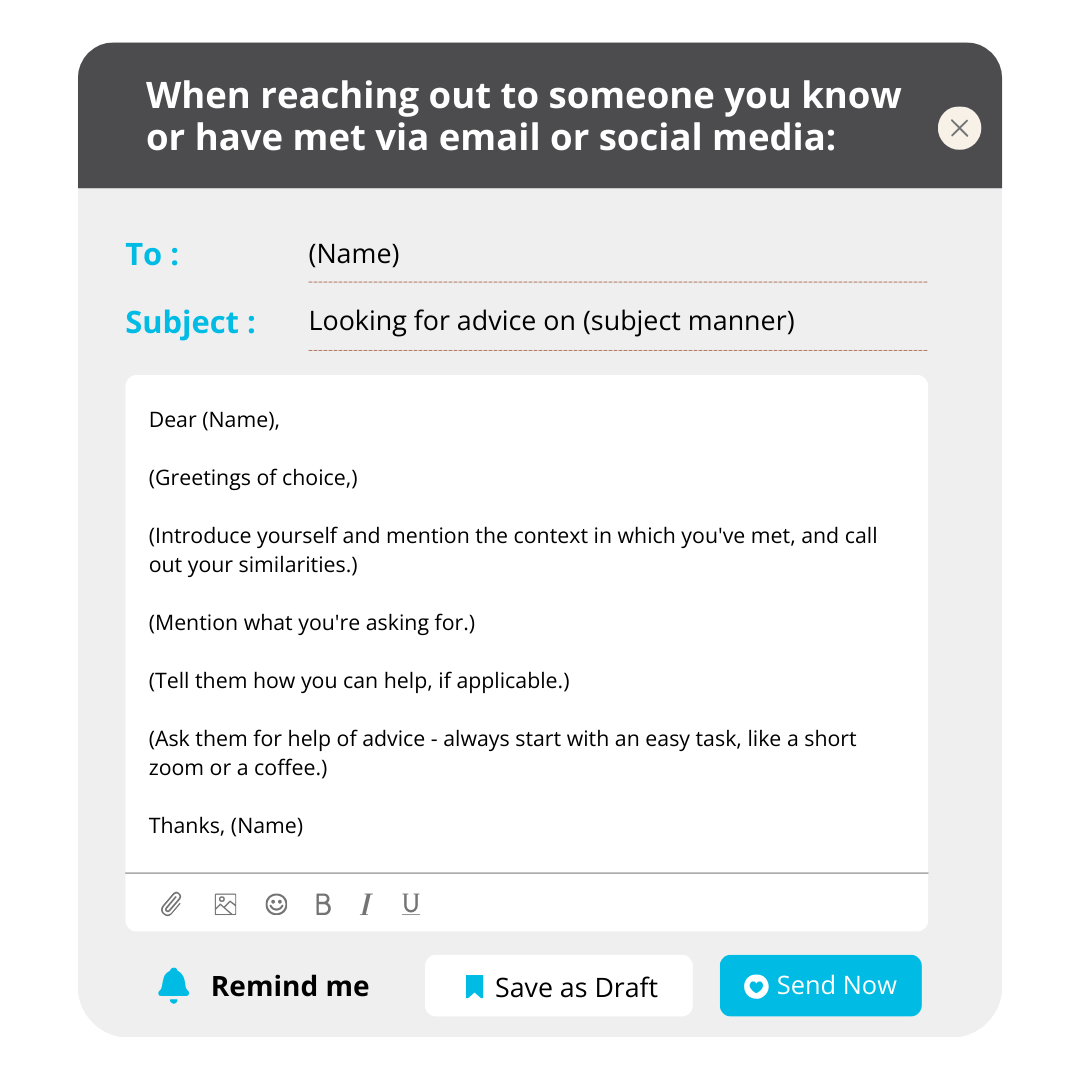
Consistency counts:
The more consistently you attend a specific professional network event, the more familiar you become. For instance, if you have been to an HR conference where you have made valuable connections in the past, it only makes sense to attend the same event every year. This helps you strengthen your existing connections and make new ones. Remember, repeated interactions strengthen bonds exponentially more than one-off meetings. People start recognising you, making it easier to engage them in conversations.
Defining Your SMART Goals
Networking isn't just about collecting business cards or connecting on LinkedIn. It's a strategic process that requires intentionality. By defining your SMART goals, you can
Focus your efforts: Rather than aimlessly attending events or contacting random contacts, having clear objectives helps you focus on what truly matters.
Measure Success: SMART goals provide a yardstick for evaluating your networking efforts. Did you achieve what you set out to do?
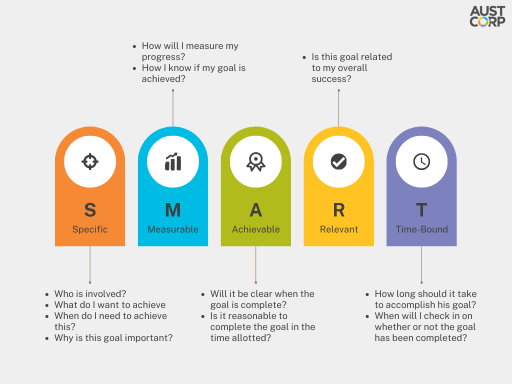
For example: "I will establish connections with five industry leaders in my field within the next two months by attending two industry conferences and engaging in three online professional forums."
Utilise your previously established contact hit list and the specific strategies you have chosen to ensure your goals are specific and measurable.
Strategising your approach
Now that you have your SMART Goals, target connections, and networking channels, it's time to break them down and create a strategy for achieving them.
A networking action plan is a detailed roadmap that outlines the steps you need to take to achieve your networking goals. It should include the names and contact details of the people you want to reach out to, the messages or script you want to use, the frequency and duration of your interactions, the follow-up actions you need to take, and the resources you need to support your networking activities.
Focus on creating annual, quarterly, monthly and weekly benchmarks that lead to the overall goals. After this, you can create weekly/daily habits that help you achieve them. For example:
Connect with ten people per day
Message 15 people per day
Attend one networking event per month
Review my network once a month
Catch up with essential people once a week.
You need to ask yourself how you will achieve your goals.
If you want in-person relationships, focus on attending industry events. If you wish to have more LinkedIn professionals in your network, focus on connecting with people on LinkedIn.
No set strategy will reach your goal; you must try different ideas and see what works.
Essential Things To Remember When Networking:
Mastering Non-Verbal Communication
When expanding your professional network, you must recognise the significant role that non-verbal cues play in your interactions. Research suggests that a substantial portion of our communication is conveyed through body language. To make a positive impression and foster meaningful connections, consider the following tips: Project Openness and Confidence.

Focusing on these aspects of nonverbal communication can significantly improve your networking outcomes and build stronger professional relationships.
Strive To Learn People's Stories - Not Just Share Your Own:
In professional networking, it's easy to fall into the trap of self-promotion, mainly driven by specific business objectives such as increasing sales, attracting investors, or recruiting talent. However, this approach often proves counterproductive. The key to successful networking lies in shifting your focus from self-promotion to genuine interest in others. Research has shown that people derive significant pleasure from talking about themselves. You create a positive and memorable interaction by encouraging others to share their experiences and perspectives. This approach makes the conversation more enjoyable for your networking partner and helps you stand out in their memory.
Moreover, taking a sincere interest in others' stories provides a wealth of information that can serve as a foundation for building lasting professional relationships. Gaining insights into their work, passions, and challenges opens up numerous avenues for meaningful follow-up conversations and potential collaborations. To implement this effectively,
Practice active listening during your interactions.
Ask thoughtful, open-ended questions that encourage detailed responses.
Show genuine curiosity about their experiences and viewpoints.
Take mental notes of critical points in their stories for future reference.
Follow up on specific topics they mentioned to demonstrate your attentiveness and interest.
Adopting this approach will enhance networking effectiveness and create more authentic and mutually beneficial professional relationships. Remember, successful networking is about building connections, not just collecting contacts.
Offer Help as often as you can:
When seeking to expand your professional network for specific goals such as obtaining referrals, attracting investors, or finding job opportunities, consider adopting a "give-first" approach. This strategy leverages the psychological principle of reciprocity, which suggests that people are naturally inclined to return favours. By offering assistance to others before asking for help yourself, you can create a positive dynamic that encourages mutual support. Importantly, providing value to your connections doesn't require a significant time investment. Consider these efficient ways to contribute:
Facilitate valuable introductions between professionals in your network.
Recommend potential clients to those in relevant fields.
Offer your expertise for quick project reviews in your area of specialization.
Share insightful articles or resources that align with your connections' goals.
Utilize your social media presence to amplify messages or promotions for your contacts.
Seize opportunities to assist your connections with manageable tasks whenever possible. This approach enhances the value of your networking efforts and cultivates an environment where others are more likely to reciprocate when you require assistance.
Focusing on how you can contribute to others' success will naturally build stronger, more mutually beneficial professional relationships. This strategy can significantly increase the effectiveness of your networking endeavours while fostering a supportive professional community.
Take the Next Step in Your Career Journey
Are you struggling to stand out in today's competitive job market? Looking for your dream job? Don't let it slip away. Contact us today for a confidential conversation with one of our recruitment consultants who can help elevate your job search and resume-building efforts.
Why connect with our recruiters?
Direct access to hiring managers and companies
Potential to bypass initial screening stages
Increased chances of securing interviews
Personalised guidance to help you stand out
Don't leave your career to chance. Let our expertise work for you. Reach out now and take the first step towards your ideal role!
Read More Career Tips and Guides
Hungry for more career advice? Check out these relevant blogs to further enhance your professional journey:
